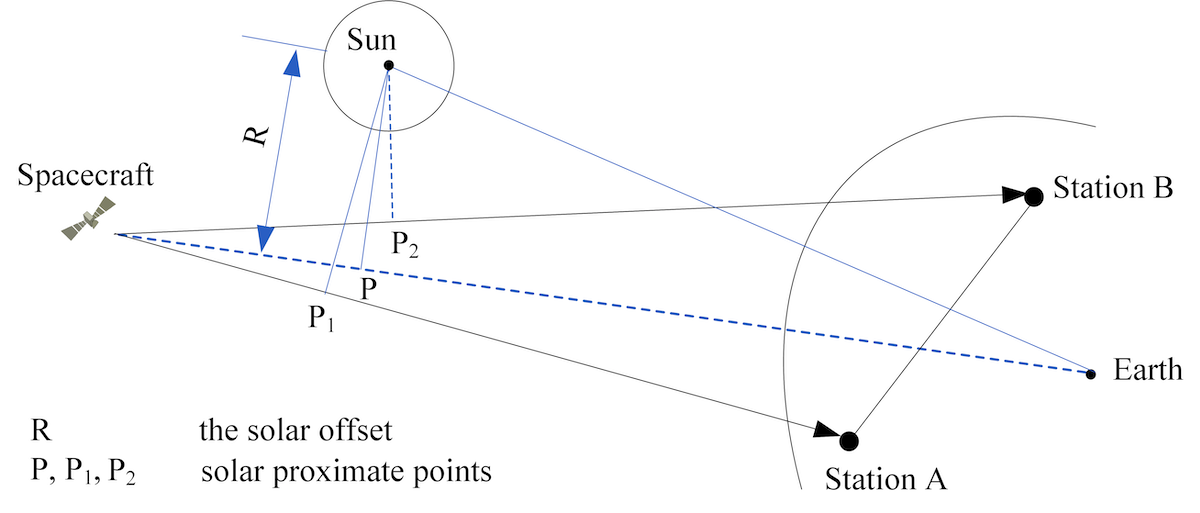
Coronal radio-sounding measurements of ESA’s Mars Express using the European VLBI Network
by Maoli Ma (Shanghai Astronomical Observatory and Shanghai Astronomical Observatory, Chinese Academy of Sciences, China), Guifre Molera Calvés (University of Tasmania, Australia), Giuseppe Cimò (Joint Institute for VLBI ERIC, The Netherlands), Peijin Zhang (University of Science and Technology of China, China), Xiong Ming (National Space Science Center, China), Peijia Li (Shanghai Astronomical Observatory, China), Pradyumna Kummamuru (University of Tasmania, Australia), Zhanghu Chu (Shanghai Astronomical Observatory, China), Tianyu Jiang (Shanghai Astronomical Observatory, China), Bo Xia (Shanghai Astronomical Observatory, China), Kondo Tetsuro (Shanghai Astronomical Observatory, China), Fengxian Tong (Shanghai Astronomical Observatory, China), Pablo de Vicente (Centro de Desarrollos Tecnológicos, Observatorio de Yebes, Spain), Jonathan Quick (Hartebeesthoek Radio Astronomy Observatory, South Africa), Hua Zhang (Xinjiang Astronomical Observatory, China) and Zhong Chen (Shanghai Astronomical Observatory and National Basic Science Data Center, China)
Very Long Baseline Interferometry (VLBI) observations of spacecraft inside the solar system have been applied to a broad range of research interests in recent years. One application is to remote sense the solar wind by the observation of a spacecraft during its solar conjunction. The VLBI baselines distributed along different Earth longitudes and latitudes form a network of projected baselines near the sun (Figure 1), provide a unique advantage to analyse the cross correlation of fluctuations among different stations, especially in the inner of the solar wind, with 10 Rs (solar radii).

The goal of our coronal radio-sounding technique is to characterise the electron density turbulence on the received signals. We have introduced two measurement methods to extract the frequency and phase fluctuations. The first method follows the pipeline processing developed by the Planetary Radio Interferometry and Doppler Experiments (PRIDE) group at the Joint Institute for VLBI ERIC (JIVE). The second called the local correlation method can be used to analysis the cross correlation of the fluctuations on multi-stations observations. Both methods have been applied to the solar conjunction observations of the European Space Agency’s Mars Express (MEX) using ground-based VLBI telescopes of the European VLBI Network (EVN) in 2015 and 2017.
First of all, we characterised the electron density turbulence from single antenna observations. The power spectral density of the frequency fluctuations at different solar offsets shows that the spectra have a near power-law shape with the mean of the measured spectral index 0.58, close to the theoretical value expected from a Kolmogorov-type turbulence spectrum. The RMS intensity of the frequency fluctuations at 11.2 Rs on 25 July 2015 is stronger than the fluctuations at 4.9 Rs and 9.9 Rs on 29 July and 3 August 2017. This is consistent with the images of the Solar and Heliospheric Observatory (SOHO/LASCO), which shows a number of bright coronal rays emanating radially from the coronal hole and crossing the LOSs (line of sights) between Earth and S/C on 25 June 2015. However, on 29 July and 3 August 2017, the LOSs were closer to the northern coronal regions with heliolatitudes of the coronal region at 70o and 40o respectively,where the rays were much fainter. The match of the fluctuations with the LASCO images further verify the correctness of our measurement methods.
Secondly, we characterised the electron density turbulence from multi-station observations. With the local correlation methods, we have obtained the electron column density fluctuations along the different LOSs from the multi-station observations on 29 July and 3 August 2017 when the solar offsets were 4.9 Rs and 9.9 Rs, respectively. The power spectral density analysis on the electron column density fluctuations shows that the fluctuations at different stations are correlated when ν < 0.01 Hz (Figure 2).
scans at the baselines Hh-Ys, T6-Ys on 3 August when solar offset was 9.9 Rs.
Encouraged by the performance of this method for characterising the electron density turbulence from VLBI baselines as well as from single stations, we are now using radio telescopes of the University of Tasmania and the EVN to observe, in the same primary beam, the ESA’s MEX and the Chinese Mars orbiter Tianwen to study the correlation of the scintillation along baselines and to estimate the solar wind velocity profile at different solar offsets.
Published in Maoli Ma et al. 2021. AJ (doi: 10.3847/1538-3881/ac0dc1).